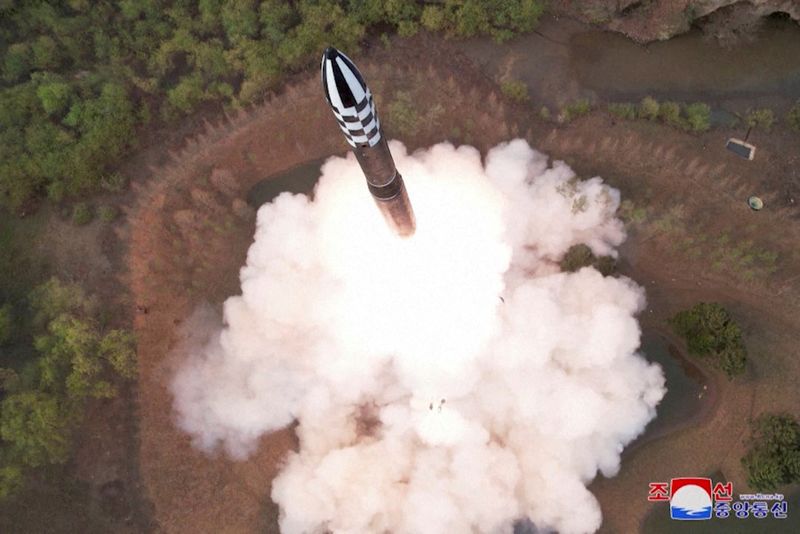Explainer-What is solid-fuel technology, and why is North Korea eager to develop it?
2023.04.14 03:45

© Reuters. A view of a test launch of a new solid-fuel intercontinental ballistic missile (ICBM) Hwasong-18 at an undisclosed location in this still image of a photo used in a video released by North Korea’s Korean Central News Agency (KCNA) April 14, 2023. KCNA
By Hyonhee Shin
SEOUL (Reuters) – North Korea says it has tested a new solid-fuel intercontinental ballistic missile (ICBM), its first known use of the propellant in a longer-range projectile, as it seeks the capability to launch with little preparation.
Here are some characteristics of solid-fuel technology, and how it can help the North improve its missile systems.
WHAT IS SOLID-FUEL TECHNOLOGY?
Solid propellants are a mixture of fuel and oxidiser. Metallic powders such as aluminium often serve as the fuel, and ammonium perchlorate, which is the salt of perchloric acid and ammonia, is the most common oxidiser.
The fuel and oxidiser are bound together by a hard rubbery material and packed into a metal casing.
When solid propellant burns, oxygen from the ammonium perchlorate combines with aluminium to generate enormous amounts of energy and temperatures of more than 5,000 degrees Fahrenheit (2,760 degrees Celsius), creating thrust and lifting the missile from the launch pad.
WHO HAS THAT TECHNOLOGY?
Solid fuel dates back to fireworks developed by the Chinese centuries ago, but made dramatic progress in the mid-20th century, when the U.S. developed more powerful propellants.
The Soviet Union fielded its first solid-fuel ICBM, the RT-2, in the early 1970s, followed by France’s development of its S3, also known as SSBS, a medium-range ballistic missile.
China started testing solid-fuel ICBMs in the late 1990s.
South Korea said on Friday it had already secured “efficient and advanced” solid-propellant ballistic missile technology.
SOLID VS. LIQUID
Liquid propellants provide greater propulsive thrust and power, but require more complex technology and extra weight.
Solid fuel is dense and burns quite quickly, generating thrust over a short time. Solid fuel can remain in storage for an extended period without degrading or breaking down – a common issue with liquid fuel.
Vann Van Diepen, a former U.S. government weapons expert who now works with the 38 North project, said solid-fuel missiles are easier and safer to operate, and require less logistical support, making them harder to detect and more survivable than liquid-fuel weapons.
Ankit Panda, a senior fellow at the U.S.-based Carnegie Endowment for International Peace, said any country that operates large scale, missile-based nuclear forces would seek solid-propellant missiles, which do not need to be fuelled immediately ahead of launch.
“These capabilities are much more responsive in a time of crisis,” Panda said.
WHAT NEXT?
North Korea said the development of its new solid-fuel ICBM, the Hwasong-18, would “radically promote” its nuclear counterattack capability.
South Korea’s defence ministry sought to downplay the testing, saying the North would need “extra time and effort” to master the technology.
Panda said the North could face difficulties ensuring such a large missile does not break apart when the diameter of the booster becomes larger.
Although the Hwasong-18 might not be a “game changer”, he said, it will most likely complicate the calculations of the United States and its allies during a conflict.
“The most important interest the United States and its allies have is to reduce the risks of nuclear use and escalation stemming from North Korea’s possession of these weapons,” Panda said.








